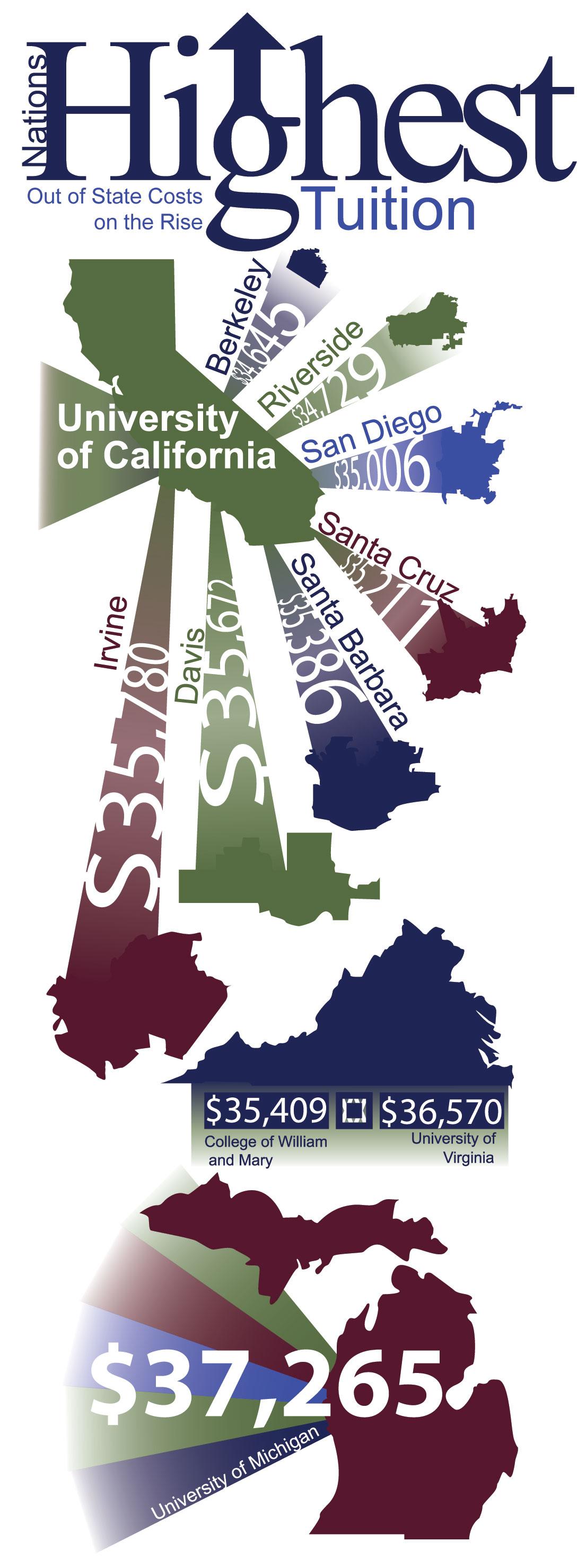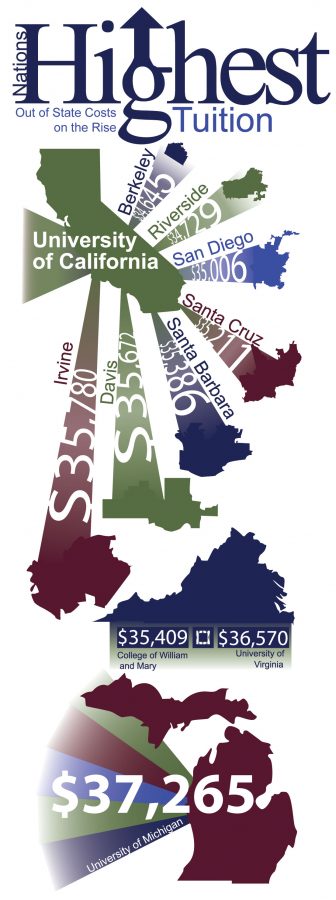
For about a year now, all I’ve wanted is to get out. I’ve just wanted to leave Columbia and venture on in life. I had my sights set on the University of Arizona-Tuscon. I did not, however, know exactly what going out-of-state for college would mean for myself financially.
Out-of-state tuition has skyrocketed in the past six years. Last year, CNN Money reported that average in-state tuition for public colleges in 2012-13 totaled $22,261 per annum. That’s not including financial aid, but that number is still higher than ever. CNN reported that the reason college tuition, especially out-of-state, is increasing is because state governments are cutting the amount of money they gave to colleges by $15.2 billion since 2007 because of inflation and America’s 2008 recession.
The number of students attending college rose 12 percent since 2007. This means even more students are having to pay crippling college fees. Not only that, but this makes the college pool larger for applicants, which means the scholarship availability could diminish, making it more expensive for all students considering higher education. With state budget cuts, not as much money is channeled into the colleges, so there is less money in the scholarship pool.
A college or university charges more to students coming from a different state because the school is supported directly by state taxpayers. Attending a school that is in the state that a person’s family pays taxes to will be cheaper than studying at a school in a different state.
What benefits do the state universities get if their only attendees are students from that state? There will be hardly any diversity among students if this continues, and students won’t have the opportunities to venture out into the world and go where they please for their education.
Truth is, the price of attending an out-of-state university that’s not even a spectacularly ranked school is getting to be almost the same price as going to an Ivy League university.
According to the University of Arizona’s website, the estimated cost of attendance for non-residence students including room and board, books and supplies, travel and miscellaneous costs add up to be $40,924, which is more than the price of the tuition to Harvard University, which is $37,576.
U.S. News and World ReportThere is a disparity between the quality of education between the University of Arizona and Harvard University. Harvard University is the number one nationally ranked best college in the United States, whereas the University of Arizona is ranked number 120 according to the
.
A $10-20,000 difference between in-state and out-of-state tuition for a college is illogical. There is no reason someone should have to pay so much more money just because the university they want to go to is in a different state. Harvard University costs the same whether the student lives in state or is from the other side of the country. All schools should cost the same for in-state and out-of-state students.
Without including scholarships, the in-state tuition at the University of Arizona is $24,744, a whole $16,180 difference between residents and nonresidents. With that difference, I could buy the sky-blue Volkswagon Convertible Beetle.
I know I’m going to end up going to college in Missouri now. I’ve weighed my options as far as college goes, and financially, it’s the right thing to do.
In 2011, USA Today claimed teens are causing student loans to soar to $100 trillion because so many more are attending college, and the Federal Reserve Bank of New York reported Americans’ debt will be greater in student loans than credit cards. I blame the ridiculous out-of-state tuition.
College is meant to prepare people for future employment, but with so many students loans, it will most likely take students years to pay off the debt. Many students may not be able to afford schools out-of-state that have a better quality of education, robbing the maximum potential of their success for their future.
U.S. News and World ReportThe
ranked the University of Missouri-Columbia higher than the University of Arizona on the best colleges, but that doesn’t mean all out-of-state schools won’t provide the same high level of education.
If colleges and universities got rid of or decreased out-of-state tuition to a decent amount compared to in-state tuition, our student loan debt wouldn’t be as high, and students could get the opportunity to venture out and go to a school not in their state. Everyone invested in the future of America’s higher education institutions needs to work together to communicate these problems to our state legislators. We need to make connections with the people who have the authority to help reform these institutions so that, ultimately, we can help connect the entire nation into one united educational opportunity. We should be enticing future generations into bettering themselves and, in turn, bettering the world around them.
It seems almost wicked of colleges to charge such exorbitant amounts of money for their own indirect benefit. If more people directly contribute to the world through research and technology, something that requires copious amounts of information retention, there should be a larger amount of state funding to the institutions that catalyze these world advancements: colleges.
By Julia Schaller














































































laurenjamison7 • Apr 25, 2013 at 10:48 am
I can really relate to this story. There are so many colleges that I would love to go to, but in reality it’s just not ideal for me to go to those places that are so much more money than instate tuition at Mizzou. I know many other people who are also frustrated at the difference in prices of out of state colleges.
Humera • Apr 25, 2013 at 10:42 am
Great article! College tuition is ridiculously high
mikaylabessey • Apr 23, 2013 at 10:30 am
I have the exact same frustration. I want to go to college in Utah, but the out-of-state tuition is SO ridiculous. I can’t believe it. Thank you for the great story.